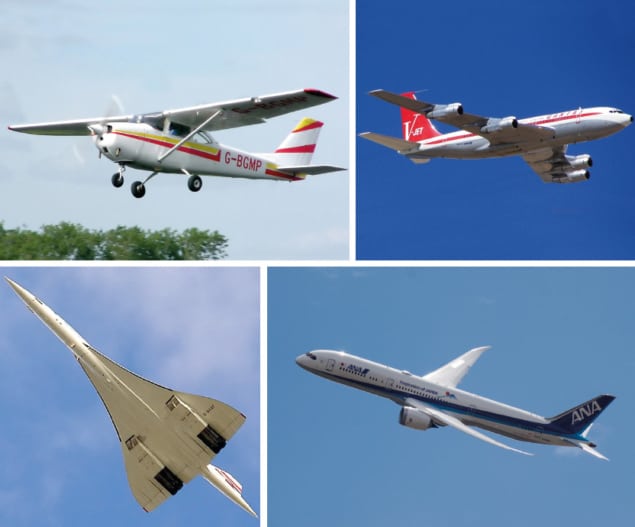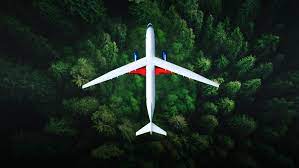Courtesy : physicsworld.com
Green aviation
Commercial air travel has changed a lot since the first aeroplane took passengers around a century ago. Brian Tillotson explores the future challenges to make aviation greener

Once upon a time, air travel was risky, costly and highly polluting. But these days modern airliners are the safest way to travel long distances, as well as being cheaper, quieter and more fuel-efficient than their predecessors. If you need to cross the US, a seat on an Airbus will get you there on less than half the fuel of an average American car – and save you three days.
Unfortunately, this efficiency is a double-edged sword, encouraging more and more people to fly or send cargo by plane. Aviation’s contribution to the world’s CO2 emissions has risen from zero to 2% within the last century despite the fact that the litres of fuel burned per passenger-kilometre has plummeted – from 10.3 l/100 passenger-km for the De Havilland Comet 4 in 1958, when commercial flight with jet engine aircraft was new, to 2.42 l/100 passenger-km with today’s Airbus A330neo-900. Furthermore, with around 107,000 commercial flights taking place every day prior to the COVID-19 pandemic, noise pollution from airports is a huge concern.
Green solutions
So, what can be done to make aviation greener? Well let’s consider Boeing’s 787 Dreamliner – a modern airliner that looks much like its noisier, less-efficient ancestor, the 707. Each has a cylindrical fuselage with a square-root-of-x nose profile, wings swept back about 35°, and jet engines sticking forward from under the wings. This shape is set by the laws of mechanics and by compressible fluid flow.
Look closer, however, and differences emerge. The Dreamliner’s engines are fatter in front, so they have a high “bypass ratio” – they put less kinetic energy into the airstream for the same amount of thrust. The engine exhaust nozzles are scalloped with a chevron shape, which creates vortices in the exhaust fumes. When high-speed exhaust mixes with the slower-moving air, the vortices make less noise than the chaotic mixing of earlier engines.
More subtly, the leading edge of the 707’s aluminium wing is straight but the Dreamliner’s is curved, which reduces fuel-wasting drag. Although the shape is too complex to be affordably built with aluminium, it is made possible thanks to a composite material – carbon-fibre-reinforced plastic (CFRP). Besides allowing aircraft components such as the wings, tail and fuselage to have a wide variety of shapes, CFRP is stiffer and has a higher strength-to-weight ratio than aluminium or steel. These factors make the aeroplane lighter, so less fuel is needed to get it off the ground and keep it airborne.
One challenge of CFRP is in the factory, where it starts as a flexible fabric or tape infused with uncured epoxy resin. This is laid on moulds by hand or by automated tape-laying machines. To make it rigid, it then has to be “cured” or baked in an autoclave at temperatures of up to 180 °C, depending on the blend of CFRP. The problem is that ensuring that every region of the part stays at exactly the right temperature is tricky, calling for careful process control and sometimes for instruments embedded within the fabric. To verify that every ply of material (there can be as many as 100 layers) lies smoothly on the one below it with no wrinkles, voids or delaminations, aircraft manufacturers use inspection methods, such as machine-vision, for automatic checks while the tape is being applied, and X-ray and ultrasound to verify each part before it’s built into a larger structure.
When lightning strikes
A big issue for CFRP is that it has a very high resistance, which is a problem when a typical commercial airliner is struck by lightning at least once a year. A bolt can carry as much as 200 kA of electrical current, which enters at one location, such as a wingtip, and exits at another, like the tail. Aeroplanes that have skin and sub-structure of mostly aluminium easily handle the current and the heat it produces at the point of attachment: engineers only need to include good conductive paths between components, skins thick enough to prevent melt-through, and internal sealant over gaps or joints to prevent arcs and sparks.
Part of the problem is that CFRP conducts electricity anisotropically. Current flows fairly easily along the fibres, which are 2000 times less conductive than copper but 30 times more conductive than silicon. However, current flows poorly between the fibres or between ply layers. Electrical potential from a lightning strike may therefore arc through the air to get around non-conductive zones, or the current may heat fibres and create a spark of vaporized material – either of which could cause a fire in a fuel tank.
Governments and manufacturers have therefore developed ways to avoid arcs and sparks. Metal foils, for example, are used on the outside of a plane to guide lightning current and protect composite skins. Other techniques include using dielectric material to isolate current and direct it away from sensitive components, and minimizing resistance in fastener installations. There are also laboratory experiments and software that can simulate lightning current, allowing us to get a better theoretical and experimental understanding of lightning attachment, arc conditions and ignition processes. Engineers can then use this knowledge to design aircraft with large margins of safety above the strongest lightning strike. These efforts have paid off. Aircraft built with CFRP wings and fuselages are routinely struck by lightning, just like their aluminium siblings, but none has had an ignition. The challenge now is to reduce the weight of these solutions so fuel economy gets even better.
While heating and arcing are direct effects of a lightning strike, it can also cause indirect effects by inducing voltage, current or force in components where the lightning current doesn’t reach. For example, a fast-changing lightning current can induce a voltage that flips a bit in nearby electronics, or it can induce eddy-current forces so strong they bend or break some components. Designers use modelling and testing to verify that indirect effects cause no problems, or that counter-measures such as shunt diodes or shielded cables keep a current spike from reaching a sensitive component.
Sweeping wings
On an aeroplane, the wings’ job is to lift the craft against gravity. It does this by deflecting air downward, which imparts downward momentum to the air and an equal upward momentum to the wings. The structure inside the wing transfers the force to the fuselage (the body of the plane) thereby allowing the aircraft to fly.
(a) Early planes featured straight, thick wings – indeed, some modern small aircraft still do. While these are structurally efficient, requiring little mass to safely transfer lifting force to the body, a tapered wing is even better. The structure is lighter than for straight wings because most lift is produced by the thick region near the fuselage, meaning it only has to transfer that lift a short distance.
A plane can also be made more stable if there is slight sweep back on the leading edge. For a plane flying straight, the wings have equal cross-section to the airstream. When the craft twists to the right, perhaps from a gust of turbulence, a swept left-wing presents a larger cross-section to the wind than the right wing. This helps the aeroplane quickly straighten out after small disturbances.
For planes with jet engines, the wings are swept back even further than for their slower, non-jet-engine counterparts – in some cases they can even be angled at more than 40°.
Jet engines allow planes to fly near the speed of sound, at transonic speeds. Air flowing over curved or thick parts of the plane must move even faster than the speed the plane is travelling, often meaning it reaches supersonic speeds (faster than the speed of sound). So when that supersonic airflow moving over those thicker parts of the wing collides with slower moving air, it creates shockwaves. A shock irreversibly transforms the air’s kinetic energy into heat and that loss of energy creates lots of drag.
The engineers who built early jets solved the problem by sweeping the wings. (b) With a straight wing’s profile, in the thick region, airflow is supersonic. (c) With a swept wing, the air follows a gentler path. Its arrival at the thick part of the wing is delayed by a factor of 1/cos(θ), where θ is the sweep angle. Air farther from the wing has more time to shift out of the way, so air near the wing has a wider “channel”. It needn’t go supersonic to get around the wing.





